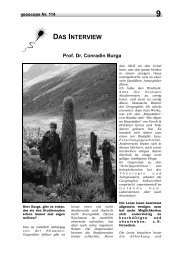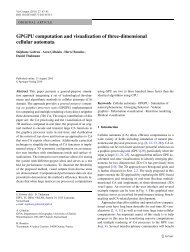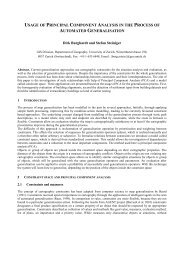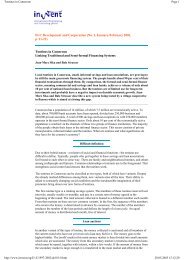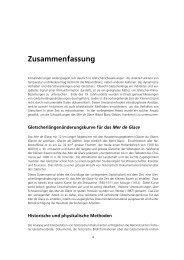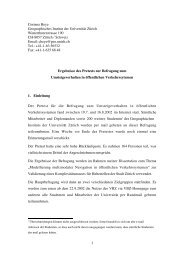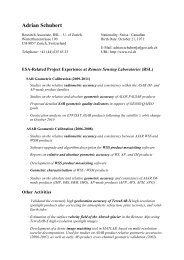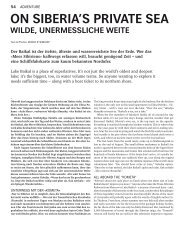KYRGYZSTAN TODAY Policy briefs on - Department of Geography
KYRGYZSTAN TODAY Policy briefs on - Department of Geography
KYRGYZSTAN TODAY Policy briefs on - Department of Geography
You also want an ePaper? Increase the reach of your titles
YUMPU automatically turns print PDFs into web optimized ePapers that Google loves.
describing the trends in the ec<strong>on</strong>omy and labor market can be based <strong>on</strong> sec<strong>on</strong>dary<br />
sources, which do not require large resources. Appropriate government<br />
authorities, in cooperati<strong>on</strong> with research organizati<strong>on</strong>s, employer’s associati<strong>on</strong>s<br />
and other partners, should initiate such publicati<strong>on</strong>s. In additi<strong>on</strong>, employers and<br />
pr<strong>of</strong>essi<strong>on</strong>al associati<strong>on</strong>s can be engaged in sectoral assessment <strong>of</strong> changes in the<br />
labor market.<br />
• Introducti<strong>on</strong> by Kyrgyz embassies and c<strong>on</strong>sulates <strong>of</strong> individuals in an “attaché”<br />
positi<strong>on</strong> and working <strong>on</strong> labor market issues, especially in Russia and Kazakhstan,<br />
could also play a positive role. Labor attachйs could not <strong>on</strong>ly analyze the trends<br />
<strong>of</strong> development <strong>of</strong> foreign labor markets, but also help public and private<br />
employment agencies to establish c<strong>on</strong>necti<strong>on</strong>s with employers.<br />
• Today Kyrgyzstan, with its limited resources, cannot c<strong>on</strong>duct proactive<br />
marketing <strong>of</strong> its labor force in Russia and Kazakhstan. Comparing Kyrgyzstan<br />
with many other nati<strong>on</strong>s that export their labor forces is not very c<strong>on</strong>structive,<br />
because the populati<strong>on</strong> <strong>of</strong> Kyrgyzstan is so small compared with, for example,<br />
the Philippines, India, Sri Lanka or Pakistan. Some problems could be solved<br />
through measures to develop the domestic labor market. Analysis <strong>of</strong> the current<br />
situati<strong>on</strong> in Kyrgyzstan’s labor market shows the origins <strong>of</strong> such phenomena<br />
as growing unemployment and an increasing proporti<strong>on</strong> <strong>of</strong> partial, sec<strong>on</strong>dary<br />
employment and self-employment. Clearly, these changes may be caused not<br />
<strong>on</strong>ly by the surplus <strong>of</strong> labor force per se. Instead, these phenomena emerge due<br />
to the imbalance between various sectors <strong>of</strong> the ec<strong>on</strong>omy, hyper-urbanizati<strong>on</strong>,<br />
c<strong>on</strong>servative system <strong>of</strong> vocati<strong>on</strong>al educati<strong>on</strong>; these do not meet the requirements<br />
<strong>of</strong> the labor market under such new c<strong>on</strong>diti<strong>on</strong>s as a lower quality <strong>of</strong> educati<strong>on</strong><br />
and problems with legal regulati<strong>on</strong> <strong>of</strong> labor relati<strong>on</strong>s.<br />
• It is important to locally create and develop the science <strong>of</strong> labor ec<strong>on</strong>omics.<br />
For example, a current topical issue that deserves serious c<strong>on</strong>siderati<strong>on</strong> is<br />
the problem <strong>of</strong> wage formati<strong>on</strong>. Despite a shortage <strong>of</strong> specialists in many<br />
pr<strong>of</strong>essi<strong>on</strong>s, Kyrgyzstan is unable to keep workers with high-demand skills<br />
in the country, losing them to emigrati<strong>on</strong> pressures caused by significant<br />
wage differentials. Moreover, the decisive role in the process <strong>of</strong> hiring is not<br />
the qualificati<strong>on</strong>s <strong>of</strong> the worker, but rather relati<strong>on</strong>ships or other social ties.<br />
This makes it essential to discover whether the problem <strong>of</strong> unmet demand for<br />
labor is truly a problem <strong>of</strong> a shortage <strong>of</strong> specialists, or it is c<strong>on</strong>nected with<br />
other properties <strong>of</strong> the local labor market. This is an outstanding field for social<br />
scientists who want to study the dynamics <strong>of</strong> the labor market at the micro<br />
level– i.e. the enterprise level.<br />
• In the near future, Russia and Kazakhstan will remain the main destinati<strong>on</strong>s <strong>of</strong><br />
labor migrati<strong>on</strong> from Kyrgyzstan. Since poor knowledge <strong>of</strong> Russian remains a<br />
major problem, recognized by both employers and emigrants, a high priority<br />
remains improving language training am<strong>on</strong>g potential emigrants. This is<br />
an initial, very practical step towards the marketing the labor force and thus<br />
improving the situati<strong>on</strong> and working c<strong>on</strong>diti<strong>on</strong>s <strong>of</strong> migrant workers.<br />
• Analysis shows that cooperati<strong>on</strong> between employers <strong>of</strong> Kyrgyzstan and<br />
vocati<strong>on</strong>al training system remains weak, exacerbating the problem <strong>of</strong> broken<br />
linkages <strong>of</strong> vocati<strong>on</strong>al training with the labor market. For example, employers<br />
who criticize the system <strong>of</strong> vocati<strong>on</strong>al educati<strong>on</strong> are <strong>of</strong>ten reluctant to help<br />
106






